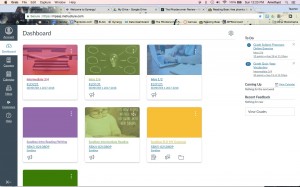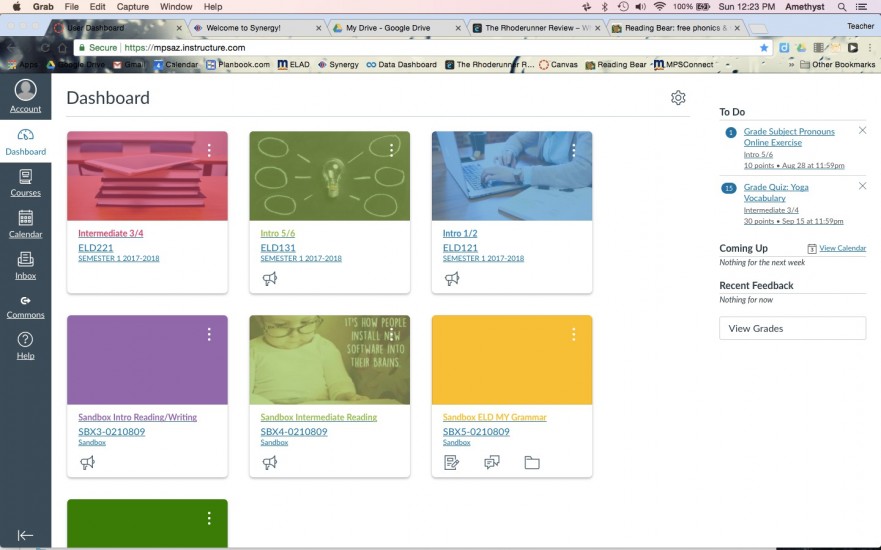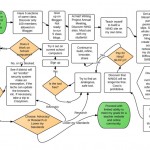I am up for breath after the first few weeks of school, and amazed at what we have accomplished in my classes in terms of implementing technology.
During the past two years, I have been lucky enough to have a set of laptops in my room. Before that, I could still get them regularly, or use the computer labs with my students. Our district has Canvas (an online class platform) and all students have access to Google Apps with their student accounts. In addition, many courses have digital textbooks, and teachers in many departments are creating shareable assessments using STARS, an online assessment platform. And of course, there are myriad free and paid websites we can use. Teachers across our school and district are all working hard to reduce paper use and increase student engagement and learning by using the technology available to us. It is a wild, woolly world of technology, so much fun to explore… though exhausting.
The cool thing about having so much tech available throughout our school is that there is a culture surrounding the basic procedures and expectations in using it that hasn’t existed in the past. Students generally need little training in how to unplug, plug in and re-rack, and carry their devices. They quickly learn how to log in to sites. They keep their water bottles capped and I don’t have to spend a lot of time policing for sneaky you-tube viewers, etc. Students know they will be held accountable for picking off the keys of their computer or not plugging it in. Students know they will need to wait for the access code on my quizzes before starting. For the most part, students settle in quickly to all of these foundational processes because they use these processes daily.
The list of things my 7th and 8th students can do at this point in the year would have blown my mind five years ago. Generally, and sometimes with help from peers or a teacher, they can:
- Use Google Drive to create, save and organize documents, slideshows, drawings and videos. Many students also know how to share files.
- Check email.
- Insert images into drawings and slideshows.
- Manipulate fonts and images in Google apps.
- Download drawings as images.
- Use Screencastify (a Chrome extension) to create videos of their desktops.

- Adjust microphone settings and, in many cases, Flash player settings.
- Clear their cached browsing history (to help use of some sites go smoother).
- Post to their individual student blogs.
- Include photos in their individual student blogs.
- Read other students’ blog entries.
- Take assessments on Canvas (basically, an online classroom used by many teachers)
- Find and complete work on Canvas.
- Submit work on Canvas.
- Play learning games for review such as Kahoot, Quizlet and Quizlet live.
- Judiciously use Google Translate as a learning resource.
Even as recently as five years ago, this kind of integration of technology into our classroom would have been either a) impossible given the resources or b) an accumulation of work evident by perhaps April or May, not mid-September.
So, part of me is exultant. Wow!
And then part of me questions:
- Have we made equally amazing progress with students’ English language skills?
- Will the time invested learning the tech tools pay off in terms of student engagement, motivation and learning?
- Is it bad that we really haven’t marked up readings copied onto copy paper?
- How does it change students’ brains to be on a screen throughout a large part of their school day?
The first three questions will follow me as I plan for the rest of the quarter and semester.
The last question weighs on me. How can we make screens a healthy part of a student’s day? It seems to be a consensus at this point that screen time actually changes our brains, and that the adolescent brain is especially vulnerable. However, as of yet, there doesn’t appear to be a lot of consensus over exactly how the screen time affects teens physically and cognitively, or which positive and negative effects are prevalent.
I found this article about ways to reduce the negative effects of screen time, and although it is aimed at parents, it seems like a good common sense guide that can be applied in the classroom as well. For example, number 1 is “increase exposure to greenery, nature, and sunlight.” Now, my room is a windowless tribute to the supreme power of air conditioning (I wear a sweater throughout the afternoon, especially on 100+ degree days). However, I can build in time to get outside, if I put my mind to it. I can also build in movement, creative kinesthetic activities, and in-person student interactions. Our daily yoga pose is probably something I should continue to implement. In fact, I am finding this list so helpful, I am going to pin it to the wall behind my desk. I am loving helping my students learn the tech so that they can use the tech to learn, but hopefully I can do as little harm along the way as possible.










Comments 6
I hope you post more on this – particularly any answers you come up with to your questions. I bet that no matter what tools you have, and the list is pretty impressive, the X – factor is the students’ personal relationship with the teacher.
Agree… my intro level students are often my go-to classes for trying a new tech tool because we tend to have a good relationship. They truly help each other and are eager to learn English and to show me they are trying hard. And of course I am constantly trying to reassure them that everything will be okay, and I am always apologizing for my own missteps. And so they are willing to be confused for a while in my class and try new things. It is so much fun.
I love reading what the students have learned. Love even more that you question kids’ screen time. As a parent, there is nothing that worries me more. I have seen the negative effects in my kids as they struggle to balance their phones, their school work, and their outside lives.
It is pretty crazy. And then when you look at how much screen time we have as adults– is this all sustainable?
Neat! This makes me think about how change can be so hard initially…but people adapt to the new “normal.” Tech integration was challenging at first, but it seems that students and teachers have really found the right solutions to implement technology that enhances learning. Perhaps one day, the ongoing debate about if/how to use technology in the classroom will be completely forgotten and obsolete.
It is true– we are shifting to a new normal, and when the tech is reliable and available, the shift is happening very quickly. The only place I still have great discomfort about the shifts is reading. Seems like there is something inherently missing when young people go straight to reading off a screen and lose all the mental processes that can happen looking at an writing on paper. It slows things down, which I think they need developmentally. I know even now, if there is material I am returning to again and again for “deep” work, such as National Boards, it benefits me to have a binder and hard copies of things I can write on and flip through. But, all of that aside, it is an exciting time… hopefully our eyeballs, brains and spines will survive!